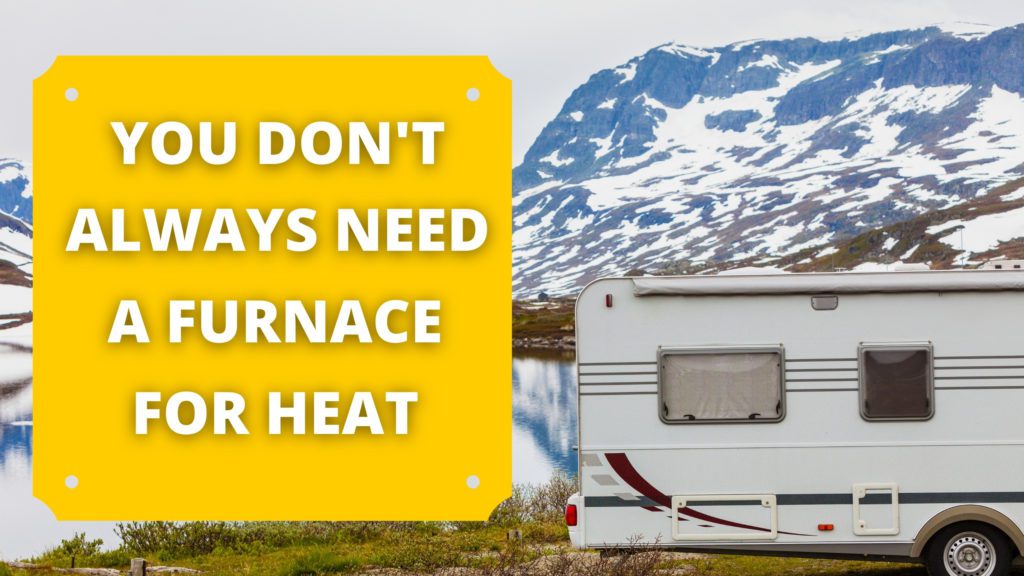If you are a full-time RVer like me, or perhaps a Van Dweller, you know the beauty of this life is spontaneity in your travels. But what do you do when your plan does not include an overnight in freezing weather? Would you be able to survive the night with just the items inside your rig and stay warm? In this blog, I share simple and affordable tips on how you can winterize your RV for winter nights and stay warm while it is freezing outside.
During one of my travels, I stopped over just outside of Winnemucca, which is in Nevada. During my two-night stay, it snowed. It was gorgeous and cold! If you thought it never snows in the desert, you have never visited the desert in November! The nighttime temperature dropped (and quick!) down to about 20 degrees. While full-time RVing, I usually do not have a rigid plan of where my travels will lead me. However, I prepare for environmental unknowns, and you should prepare as well!
(*Note: I have Amazon affiliate links on my website and in this blog. DISCLAIMER: Carolyn’s RV Life and Carolyn Higgins share her experiences, thoughts, opinions and ideas in this blog post and on this website for entertainment purposes only. It is not intended to be a substitute for professional advice, instruction or guidance. Viewers/Readers should consult with professionals before pursing any actions or behaviors exhibited in this video. Carolyn’s RV Life or Carolyn Higgins cannot be held liable in the event of any accident or injury that may occur as a result of application of procedures and information provided in this blog and video.)

Here are some simple tricks and tips to help keep the inside of your RV warm and cozy on freezing nights and cold days too.
Don’t like to read? Watch the video instead on YouTube and follow my channel for more tips.
3. Cover the House Windows. You probably have curtains that cover your side windows. In addition to closing your curtains, you can put up a lightweight fleece blanket that can cover the entire width and length of each window. I hang the blanket by folding it over my curtain rod. A tip for more insulation is to leave some extra blanket at the top when you fold it over the curtain rod. Doing this creates more of a cushion and filler to seal the top of the window and prevent outside air from drafting in. Remember to cover the small window in the kitchen area as well.
4. Cover the Door. The door can be a huge culprit for bringing in cold air. If your weather stripping is old or failing, you need an extra layer of protection against the cold air seeping in. I installed a little curtain rod over my door to hang a thermal blackout curtain panel to cover the doorway. Make sure your curtain is wide enough to cover the whole door and can touch the floor as well.
5. House Battery Compartment. Next, fill in the area where house battery access is. Mine is right in front of the door. If you travel with a dog as I do, you can place your pet’s bed there to create a barrier on the floor. If not, lay a big blanket or pillows from your sofa in the area.
6. Keep the Bathroom Door Closed. Yes, this should be obvious. Keeping this door closed will trap the cold air in the bathroom instead of seeping out into your sleeping quarters.


Whether you are primarily boondocking or do not want to drain your battery using the furnace, or maybe your furnace quit like mind did, there are other ways to heat your RV.

2. Catalytic Heaters. If you are worried about CO2, a catalytic heater is another alternative. Catalytic heaters use chemical reactions to produce heat, which means no CO2.
3. Electric Space Heater. If you are at a campsite with hookups, an electric space heater is an option instead of using your furnace. Take caution as these can be a fire risk. I suggest finding a model with built-in safety features for shutting off if knocked over or too hot.
You will never be able to keep things from freezing if you are indeed in freezing weather, but there are measures you can take to make sure your pipes and tanks do not break. Water in your black and grey tanks will freeze when you are in freezing weather conditions.

2. Turn off your Water Pump and Open Faucets. Water left in your pipes will freeze. Everybody who lives in an RV and dry camps relies on the water pump. Turn your water pump off. Turn your faucets on to empty all of your water, including your shower. Remember to make sure no water is remaining in your toilet. You can pull the toilet lever releasing the remaining water for the flush to drain.
It can take a few hours for things to thaw out. You may not have running water for a while if not hooked up to city water.

And that is it! Simple steps to survive some freezing nights. Notice I said SOME, as in a few. These are steps I take because I know I will not be in the cold weather for long. The few times that I have had to stay overnight in freezing temperatures, as low as 15 degrees, the steps I’ve shared have worked very well for me. Enjoy your travels! Stay warm, stay safe. And as always…
BE HAPPY, BE FREE, BE KIND.
Curious about Full-Time RV Life? Here are some fun facts >>> Fun Facts of RV Life
Check out my list of places you can Remote Boondock in a larger RV.
DISCLAIMER: Carolyn’s RV Life and Carolyn Higgins share her experiences, thoughts, opinions and ideas in this blog post and on this website for entertainment purposes only. It is not intended to be a substitute for professional advice, instruction or guidance. Viewers/Readers should consult with professionals before pursing any actions or behaviors exhibited in this video. Carolyn’s RV Life or Carolyn Higgins cannot be held liable in the event of any accident or injury that may occur as a result of application of procedures and information provided in this video.
Join the Fun! Subscribe to Carolyn’s RV Life email list and get stories, pictures, videos, advice, tips, and more!
Want to receive sneak peaks, insider news and exclusive content? Join the Carolyn’s RV Life Patreon Community!